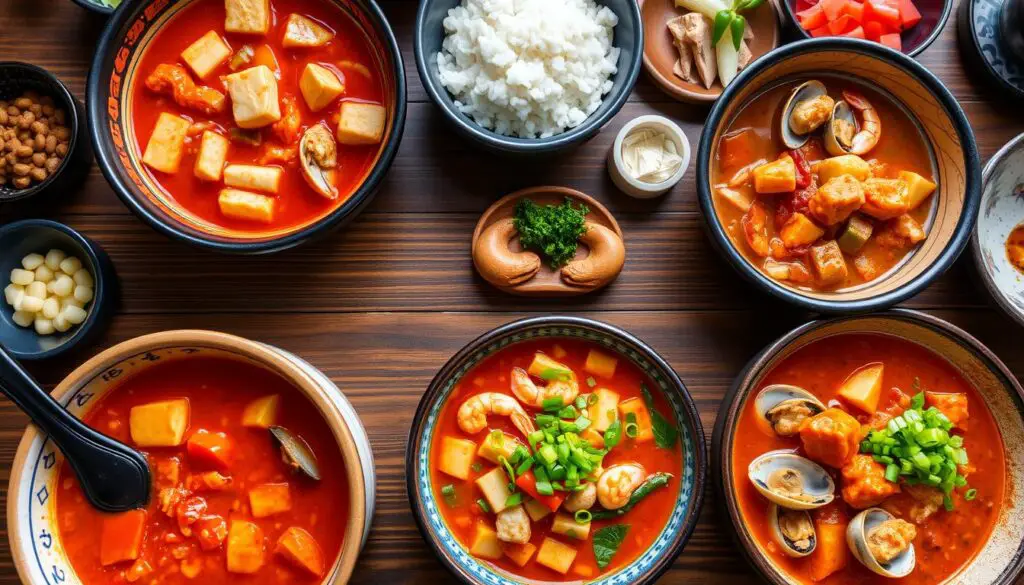Kimchi Jjigae, the classic Korean spicy stew, is a robust dish. It pairs well with many foods. To make your meal better, try it with steamed rice, grilled meats like bulgogi or galbi, kimchi pancakes, and fresh vegetable side dishes.

The stew’s flavors are spicy, sour, salty, savory, and sweet. The right foods can balance these tastes perfectly.
Introduction to Kimchi Jjigae
Kimchi Jjigae is a spicy Korean stew loved by many. It’s made with fermented kimchi, giving it bold flavors. This dish is a key part of Korean food, loved both at home and around the world. Let’s explore what makes it so special.
What is Kimchi Jjigae?
Kimchi Jjigae, or Korean Kimchi Stew, is a spicy dish. It combines napa cabbage kimchi, meat like pork belly, and tofu. The mix of spicy, sour, salty, and umami flavors makes it a standout dish.
Origins and Popularity
Kimchi Jjigae has deep roots in Korean cuisine. It started when chili peppers came to Korea in the Joseon era (1392–1897). Now, it’s a favorite stew in Korea, loved by many at home and abroad.
Today, people worldwide enjoy Kimchi Jjigae. It shows the variety and richness of Korean food. Its flexibility has led to many variations, making it a beloved comfort food.
Classic Accompaniments
Enjoying a steaming bowl of kimchi jjigae is even better with classic Korean side dishes, or banchan. These traditional sides for kimchi jjigae balance the bold flavors. They make the meal complete.
Steamed white rice is at the heart of the meal. Its neutral taste is perfect with the spicy kimchi jjigae. This pairing is a key part of classic Korean dishes to serve with kimchi stew.
Alongside rice, you’ll find staple accompaniments for kimchi jjigae. Grilled meats like bulgogi (marinated beef) or galbi (short ribs) add savory contrast. Kimchijeon (kimchi pancakes) are also a favorite banchan that matches the bold flavors of the jjigae.
Refreshing vegetable dishes, or namul, like seasoned spinach or sautéed bean sprouts, are great too. These classic Korean dishes to serve with kimchi stew refresh your palate. They balance the meal.
These traditional sides for kimchi jjigae make a complete and satisfying meal. They celebrate Korea’s rich culinary traditions.
Savory Side Dishes
Kimchi Jjigae is a delicious and hearty dish. Korean cuisine has many savory side dishes that go well with it. Korean fried chicken and japchae are great examples. They add to the meal, making it more satisfying.
Korean-style sautéed spinach is a popular side. It’s made with garlic, soy sauce, and sesame oil. This dish contrasts nicely with the spicy stew. Japchae, with its sweet potato noodles and vegetables, also pairs well. It has a chewy texture and complex flavors.
Korean fried chicken is perfect for a crispy side. The meat is juicy and the outside is crunchy. It balances out the flavors and textures of Kimchi Jjigae.
| Savory Side Dish | Key Characteristics | Flavor Profile |
|---|---|---|
| Korean-style Sautéed Spinach | Tender greens, garlic, soy sauce, sesame oil | Savory, umami, slightly sweet |
| Japchae | Sweet potato glass noodles, vegetables, sweet soy sauce | Sweet, chewy, complex |
| Korean Fried Chicken | Juicy, tender meat, crispy exterior | Savory, indulgent, satisfying |
These side dishes enhance the flavors of Kimchi Jjigae. They add variety in texture, making the meal balanced and enjoyable. Whether you prefer crunchy, chewy, or sautéed, Korean cuisine has something for everyone.
What to Eat With Kimchi Jjigae?
Kimchi Jjigae, the iconic Korean stew, is a versatile dish. It pairs well with many foods. You can enjoy it with steamed white rice or other savory dishes and proteins.
Grilled or braised meats like bulgogi (marinated beef), galbi (short ribs), or samgyeopsal (pork belly) are great with it. These meats balance the stew’s bold, spicy flavors.
Seafood lovers will enjoy Kimchi Jjigae with fish and shellfish. Try Godeungeo jorim (braised mackerel), saeu jorim (spicy shrimp), or canned tuna for a complete meal.
Vegetarians and vegans can also enjoy Kimchi Jjigae. Pair it with sautéed or grilled tofu, simmered mushrooms, or Korean banchan (side dishes) like japchae and namul.
Experimenting with different pairings is key. Find your favorite foods to eat with kimchi jjigae, what to serve with kimchi stew, and recommended pairings for kimchi jjigae.

Variations and Adaptations
Kimchi Jjigae, the beloved Korean stew, is a dish that can be easily adapted to suit various dietary preferences and tastes. Whether you’re a vegetarian, vegan, or a meat-lover, there are plenty of ways to enjoy this flavorful dish.
Vegetarian and Vegan Options
For those following a vegetarian or vegan lifestyle, the traditional vegetarian kimchi jjigae and vegan kimchi stew offer delicious alternatives. These plant-based versions of the dish swap out the typical pork for protein-rich options like tofu, tempeh, or an assortment of mushrooms. The result is a hearty, umami-packed stew that satisfies the palate without compromising on flavor.
Meat and Seafood Variations
Carnivores need not miss out on the goodness of Kimchi Jjigae. Variations featuring meat and seafood additions like pork belly, beef, canned tuna, or mackerel provide a different take on the classic recipe. These adaptations of traditional kimchi jjigae allow the dish to cater to a wider range of taste preferences while keeping the core essence of the Korean dish.
Regardless of your dietary preferences, Kimchi Jjigae’s versatility ensures that there’s a version to suit every palate. By embracing these variations, you can explore the depth and diversity of this beloved Korean culinary delight.

Balancing Flavors
The secret to loving Kimchi Jjigae is balancing its bold flavors. You need spicy, sour, salty, savory, and sweet notes. If the kimchi is too sour, a bit of sugar can soften it. On the other hand, if it’s not sour enough, rice vinegar or sauerkraut can add tanginess.
Seasoning with Korean chili powder, soy sauce, and other ingredients is key. It makes sure the dish tastes great together. This process of adjusting seasoning in kimchi stew is essential for achieving the perfect flavor balance in Korean kimchi jjigae.
The rich taste of Kimchi Jjigae comes from fermented kimchi and savory pork. By balancing flavors in kimchi jjigae, you make a stew that’s both cozy and complex. Each ingredient adds something special to the taste.
Serving Suggestions
Kimchi Jjigae is best served hot and bubbly in individual bowls. The broth and ingredients create a comforting meal. Serving it with steamed rice balances the bold flavors.
For a nice look, garnish with green onions before serving. This adds color and a hint of onion flavor. Letting the stew rest and reheat can make it even tastier.
Kimchi Jjigae is often part of a shared Korean meal. Serving it with grilled meat or fish adds to the experience. This style of eating fosters conversation and togetherness, capturing the heart of Korean traditions.
| Serving Suggestion | Benefit |
|---|---|
| Serve Kimchi Jjigae in individual bowls | Maintains the stew’s temperature and provides a personal dining experience |
| Accompany with a side of steamed rice | Balances the bold flavors of the stew and adds a comforting carbohydrate |
| Garnish with sliced green onions | Adds a vibrant pop of color and subtle onion flavor to the dish |
| Allow the stew to rest and reheat | Enhances the depth of flavor and makes the dish even more delectable |
| Serve Kimchi Jjigae as part of a shared meal | Encourages a communal dining experience and showcases the essence of Korean cuisine |
By following these tips, you can make your Kimchi Jjigae experience unforgettable. Whether alone or with family, these suggestions will enhance the flavors and presentation of this beloved Korean dish.
Conclusion
Kimchi Jjigae, the beloved Korean stew, can be made even better with the right sides. You can choose classic rice and savory dishes or try new things like vegetarian, meat, or seafood. The secret is to find the perfect mix of flavors.
The beauty of Kimchi Jjigae lies in its flexibility. You can make it your own by trying different foods with it. From traditional choices to creative twists, there’s always something new to try.
Exploring Kimchi Jjigae is all about trying new things. Don’t be afraid to mix and match to find what you like best. Whether you stick to the classics or try something new, the goal is to enjoy the amazing flavors of Kimchi Jjigae.









